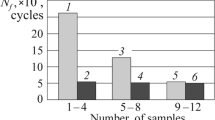Abstract
In order to predict the mechanism of the formation and propagation of rolling contact fatigue cracks in Hadfield steel railway crossings (HSRC), the residual strain, microstructure, crystal orientation, and microhardness surrounding fatigue cracks were investigated. Results show that the formation and propagation of fatigue cracks in HSRC have no correlation with the crystal orientation and boundaries of grains. The hardness and residual strain in the field around the fatigue crack are lower than those in other regions. The compressive strain around the fatigue crack is released after crack propagates, which reduces the hardness around the fatigue crack. Deformation twins and dislocations play a key role in the work hardening of HSRC.
Similar content being viewed by others
References
Dastur Y N, Leslie W C. Mechanism of work hardening in Hadfield manganese steel. Metall Mater Trans A, 1981, 12: 749–753
Wang J. Focuses of material science development in recent years. Sci China Tech Sci, 2011, 54: 1645–1648
Wang L, Bei H, Gao Y F. Effect of residual stresses on the hardness of bulk metallic glasses. Acta Mater, 2011, 59: 2858–2864
James M N, Ting S P, Bosi M, et al. Residual strain and hardness as predictors of the fatigue ranking of steel welds. Int J Fatigue, 2009, 31: 1366–1377
Nie W J, Wang X M, Wu S J, et al. Stress-strain behavior of multi-hase high performance structural steel. Sci China Tech Sci, 2012, 55: 1791–1796
Shawn A, Nagaraj K. Effects of the strain-hardening exponent on two-parameter characterizations of surface-cracks under large-scale yielding. Int J Plast, 2011, 27: 920–939
Adams B, Wright S, Kunze K, et al. Orientation imaging: The emergence of a new microscopy. Mater Trans A, 1993, 24: 819–831
Guo N, Liu Q, Xin Y C, et al. The application of back-scattered electron imaging for characterization of pearlitic steels. Sci China Tech Sci, 2011, 54: 2368–2372
Chen S, Yu H. Investigation on martensitic steel using a quenching-artitioning-tempering process via electron backscatter diffraction analysis. Sci China Tech Sci, 2012, 55: 646–651
Wilkinson A J, Meaden G, Dingley D J, et al. High-resolution elastic strain measurement from electron backscatter diffraction patterns: New levels of sensitivity. Ultramicroscopy, 2006, 106: 307–313
Phani S, Karamched A, Wilkinson J. High resolution electron back-catter diffraction analysis of thermally and mechanically induced strains near carbide inclusions in a superalloy. Acta Mater, 2011, 59: 263–272
Miles M P, Fullwood D, Adams B L, et al. Room temperature ductility and microstructure of magnesium AZ31B sheet. J Mater Eng Perform, 2011, 20: 1357–1363
Venegas V, Caleyo F, Gonzaleza J L. EBSD study of hydrogen induced cracking in API-5L-X46 pipeline steel. Scripta Mater, 2005, 52: 147–152
Oliver W C, Pharr G M. An improved technique for determining hardness and elastic modulus using load and displacement sensing indentation experiments. J Mater Res, 1992, 7: 1564–1568
Papadopoulos C A. The strain energy release approach for modeling cracks in rotors: A state of the art review. Mech Syst Signal Pr, 2008, 22: 763–789
Adams B L, Wright S I, Kunze K. Orientation imaging: The emergence of a new microscopy. Metall Mater Trans A, 1993, 24: 819–823
Blochwitz C, Jacob S, Tirschler W. Grain orientation effects on the growth of short fatigue cracks in austenitic stainless steel. Mater Sci Eng A, 2008, 496: 59–66
Lv B, Zhang M, Zhang F C, et al. Micro-mechanism of rolling contact fatigue in Hadfield steel crossing. Int J Fatigue, 2012, 44: 273–278
Rahman M, Hancock J W. Elastic perfectly plastic asymptotic mixed mode crack tip fields in plane stress. Int J Solids Struct, 2006, 43: 3692–3704
Gao X, Wang H G, Kang X W. Analytic solutions to crack tip plastic zone under various loading conditions. Eur J Mech A/Solid, 2010, 29: 738–745
Belnoue J P, Jun T S, Hofmann F, et al. Evaluation of the overload effect on fatigue crack growth with the help of synchrotron XRD strain mapping. Eng Fract Mech, 2010, 77: 3216–3226
Shen Y F, Lu L, Lu Q H, et al. Tensile properties of copper with nano-scale twins. Scripta Mater 2005, 52: 989–994
Author information
Authors and Affiliations
Corresponding author
Rights and permissions
About this article
Cite this article
Feng, X., Zhang, F., Zheng, C. et al. Micromechanics behavior of fatigue cracks in Hadfield steel railway crossing. Sci. China Technol. Sci. 56, 1151–1154 (2013). https://doi.org/10.1007/s11431-013-5181-x
Received:
Accepted:
Published:
Issue Date:
DOI: https://doi.org/10.1007/s11431-013-5181-x




